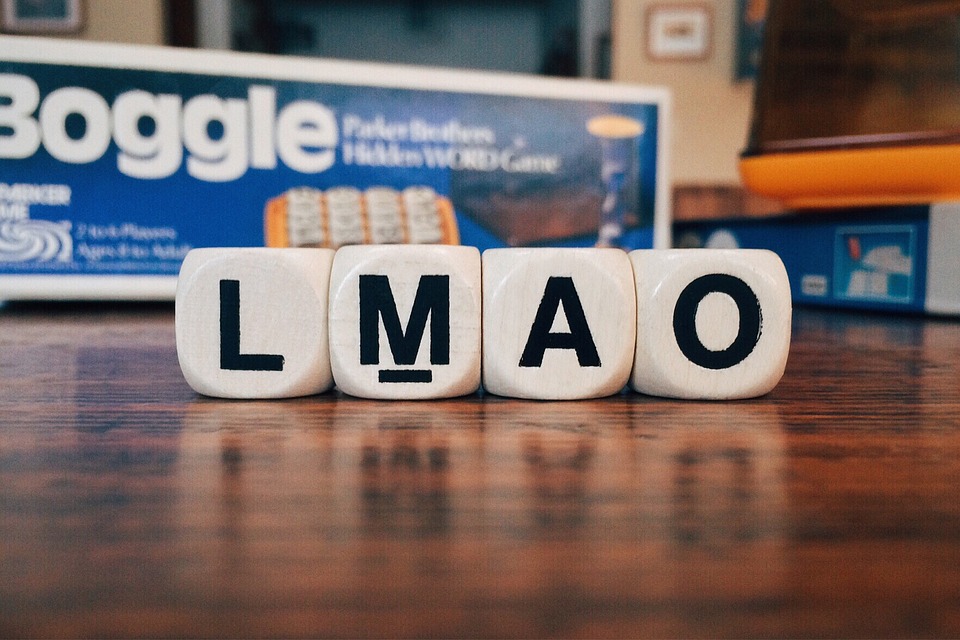BWTDCC
(better ways to describe complicated crap)
The mortgage industry loves acronyms. But it was not until the last blog posting (scroll down to Wells after the click …) that I had the brilliant idea of creating NEW acronyms – ones that are more descriptive, colorful, and clear! I determined I needed to do this quickly just in case TPD (The President Donald) signs Executive Orders disbanding Dodd-Frank or CFPB, eliminating mortgage industry acronyms, or establishing an OOCS (Office of Common Sense).
And great minds may be thinking alike here. Literally two days after my flash of insight, the National Mortgage News published a snappy slideshow, “10 Mortgage Abbreviations Everyone in the Industry Should Know”. I am grateful for their assistance and will use what they chose because WRTW? (Why Reinvent the Wheel).

1. HOEPA -- In September 1994, President Clinton signed into law the Home Ownership and Equity Protection Act. You can click on this link (consumerfinance.gov) and peruse 41 thrilling pages about it. But please tolerate my twisted sense of humor and take a gander at just this excerpt from page 14.
… you determine that a transaction is not exempt from HOEPA coverage, then you must apply the HOEPA coverage tests to determine if the transaction is a high-cost mortgage. There are three separate HOEPA coverage tests, based on:
- The transaction’s annual percentage rate (APR)
- The amount of points and fees paid in connection with the transaction
- The prepayment penalties you may charge under the loan or credit agreement
- APR coverage test (§ 1026.32(a)(1)(i) and comments 32(a)(1)(i)-1 to -3 and 32(a)(1)(i)(B)-1)
First, determine if a transaction is a high-cost mortgage based on its APR. A transaction is a high-cost mortgage if its APR (measured as of the date the interest rate for the transaction is set) exceeds the Average Prime Offer Rate (APOR) for a comparable transaction on that date by more than:
- 6.5 percentage points for first-lien transactions, generally
- 8.5 percentage points for first-lien transactions that are for less than $50,000 and secured by personal property (e.g., RVs, houseboats, and manufactured homes titled as personal property)
- 8.5 percentage points for junior-lien transactions
Is that beautiful or what? NO WONDER they need an acronym! But, for me, Hoepa simply doesn’t cut it. In short, this test determines if consumers are getting ripped off, charged too high, or financially screwed. Why not just call it that? PROPOSAL: Hoepa becomes the WIS law – for Was I Shafted? Simple, clear, easy to understand – voila!

2. SFHA -- AKA, Special Flood Hazard Area. On its web site, the International Risk Management Institute, Inc. defines SFHA as:
“A term used by the Federal Emergency Management Agency (FEMA) in the National Flood Insurance Program (NFIP) to refer to the land area covered by the floodwaters of the base or 100-year flood (an area of land that has an approximate 1 percent probability of a flood occurring on it in any given year). In these areas, the NFIP's floodplain management regulations must be enforced, and the mandatory purchase of flood insurance applies. Structures located in SFHAs have a 26 percent chance of suffering flood damage over the normal 30-year life of a loan, according to FEMA. Structures that are not located in SFHAs are viewed as less subject to flooding. SFHAs are identified in flood insurance rate maps (FIRMs).”
You have to love a definition of an acronym that uses 3 other acronyms in the definition itself! And clearly based on the mathematics described above, everyone is in a flood zone. Therefore, I think we shall call this WAO, pronounced wow, and of course standing for Water Add On. Now everyone will need flood insurance and there will be no surprise, other than the amount of the monthly fee – wow.

3. RHS is the abbreviation for Rural Housing Service. This is an easy one, right? This is a loan for farm land? Well, no. RHS falls under the United States Department of Agriculture and Rural Development. And here is what the applicable web site states:
“USDA’s Rural Housing Service offers a variety of programs to build or improve housing and essential community facilities in rural areas. We offer loans, grants and loan guarantees for single- and multi-family housing, child care centers, fire and police stations, hospitals, libraries, nursing homes, schools, first responder vehicles and equipment, housing for farm laborers and much more.
We also provide technical assistance loans and grants in partnership with non-profit organizations, Indian tribes, state and federal government agencies, and local communities.
We and our partners are working together to ensure that rural America continues to be a great place to live, work and raise a family.”
We and your editors cannot possibly top this assemblage of blah-di-blah and have no clue what this explanation means. It shall, therefore, remain RHS.
4. DTI is mortgage industry lingo for debt-to-income, or the ratio of how much you owe versus how much you earn. Many lenders and home buying web sites offer “DTI Calculators” to help people determine their “ratio”. See, for example, Bankrate, Zillow, or Wells Fargo. Many attribute the mortgage crisis to incorrect DTI computation. Okay, let’s get real here. If a borrower make $3,000 per month but somehow states $10,000, the DTI ratio will be, err, different. So, let’s now call this one the LILIPOF ratio, of course standing for liar, liar, pants on fire!

5. UETA – No, this does not represent a cross over between a Urologist’s and a Mortgage Loan Officer’s diagnosis. UETA refers to the Uniform Electronic Transactions Act, which is related to but not exactly the same as the Electronic Signatures in Global and National Commerce (ESIGN) Act. Here is Docusign
The ESIGN Act is a federal law passed in 2000. It grants legal recognition to electronic signatures and records if all parties to a contract choose to use electronic documents and to sign them electronically.
UETA, a precursor to the ESIGN Act, was introduced in 1999 and has been adopted by 47 U.S. states, as well as the District of Columbia and the U.S. Virgin Islands. Among other things, UETA provides that when a law requires either a writing or a signature, an electronic record or an electronic signature can satisfy that requirement when the parties to the transaction have agreed to proceed electronically.
UETA and the ESIGN Act solidified the legal landscape for use of electronic records and electronic signatures in commerce by confirming that electronic records and signatures carry the same weight and have the same legal effect as traditional paper documents and wet ink signatures. * Both laws provide the following:
No contract, signature, or record shall be denied legal effect solely because it is in electronic form
A contract relating to a transaction cannot be denied legal effect solely because an electronic signature or record was used in its formation
*The law for electronic signatures in most countries spells out certain types of documents or document categories for which electronic signatures are not appropriate. Each customer should work with legal counsel to identify categories of exclusion in the relevant country, but common categories of exclusion are wills and trusts, powers of attorney, and declarations given under oath.
Let’s combine these acronyms and strive for clarity by calling the entire mess E Sig – sign ‘em and smoke ‘em if you got ‘em?

6. PITI – referring to how much a home owner pays each month for direct mortgage related expenses, PITI stands for principal plus interest plus taxes plus insurance. Note that PITI is part of DTI, as explained above in #4. Since PITI is just a perfect acronym for so many reasons, we shall leave this as is.
7. ATR -- The Ability to Repay is an acronym borne from the CFPB. Investopedia explains that ATR is essentially,
“An individual's financial capacity to make good on a debt. Specifically, the phrase "ability to repay" was used in the 2010 Dodd-Frank Wall Street Reform and Consumer Protection Act in Title XIV, the Mortgage Reform and Anti-Predatory Lending Act, to describe the requirement that mortgage originators substantiate that potential borrowers can afford the mortgage they are applying for. “
Yes, ATR involves #4 DTI (or LILIPOF) and #6 PITI (still PITI) -- but probably Not #8 below. However, since LILIPOFPITI has such a nice international lilting sound to it … lill e pof piti … we shall incorporate that into the mortgage acronym world immediately.

8. NINA – nina, nina, bobina, banana fana for bina … sorry, wrong era. Anyway, NINA is the mortgage phrase always preceded by scary music, anxiety, or smirks, depending on your position in the mortgage industry. It stands for No Income, No Asset verification. Formerly, it was commonly known as a Liar Loan or a Stated Income loan. Let’s lump NINA, Liar Loan and Stated Income together and call it one name – the SI loan (pronounced sigh, as in big sigh).
Before we leave this topic, let me reminisce about the famous (infamous) story from 2006 that told the tale of the nail technician. Said professional obtained a million-dollar mortgage based on her stated income of $50,000 per month – painting fingernails. No, she was not nail artist to the stars. No, she was not located in LA or NYC. Well, big SI. And, industry news tells us, these SI loans are bbbbaaaccckkkk.
9. LLPA – so what exactly is Loan Level Price Adjustment? Click here for the six page FNMA pdf explaining all about it. Or, per the Mortgage Reports,
“A loan-level pricing adjustment (LLPA) is a risk-based fee assessed to mortgage borrowers using a conventional mortgage. Loan-level pricing adjustments vary by borrower, based on loan traits such as loan-to-value (LTV), credit score, occupancy type, and number of units in a home. Borrowers often pay LLPAs in the form of higher mortgage rates.”
Hang on a minute. Is this a legal way of committing WIS from #1 above? No, no, no – its risk based, it’s based on costs to service loans, it’s based on anticipated loan performance … Well maybe, sort of. Let’s, therefore, call this one WISSO – for … Was I Shafted, Sort Of! 🙂

10. UCDP -- Uniform Collateral Data Portal - This one is a lot of words that have to do with the property appraisal. Check out the 100 page “User Guide” explaining ALL about it. Or take a gander at, “single portal through which lenders electronically submit appraisal reports …” Can I get a “YIKES!”?
What is all this about? As it happens, the nail technician discussed above may have purchased a home that someone’s brother-in-law’s cousin acting as an appraisal said was worth millions. But, alas, it wasn’t worth even half of that in the “real world”. That sort of, kind of led to the UCDP. But, the GSE’s (Fannie and Freddie) realized they needed to start collecting collateral data. As Veros explains it,
“UCDP is a single joint portal for the electronic submission of appraisal data files to Freddie Mac and Fannie Mae (GSEs). It facilitates the electronic collection of appraisal report data prior to loan delivery for conventional mortgages delivered to the GSEs.
UCDP is part of a larger initiative known as the Uniform Mortgage Data ProgramSM (UMDPSM) and is a joint program created under the direction of the GSEs' regulator, the Federal Housing Finance Agency (FHFA) to provide common requirements for appraisal and loan delivery data.”
Frankly, I think they could have included a few more acronyms in that!
What we are doing then, is collecting appraisal data. Let’s just call it that, what do you say? I propose UCDP becomes ADD – appraisal data dump!

And there you have it – BWTDCC -- better ways to describe complicated crap! But in case you were not fond of my new acronyms, let me respectfully leave you with this excerpt from humorpedia.com.
- A.D.I.D.A.S. = All Day I Dream About Soccer
- B.M.W. = Big Money Waster
- BING = Bing Is Not Google
- D.E.N.I.A.L.= Don’t Even Know I Am Lying
- D.I.E.T. = Did I Eat That?
- F.O.R.D. = Fix Or Repair Daily
- M.A.T.H. = Mental Abuse to Humans
- M.C.D.O.N.A.L.D. = Making Children Diners Order Nuggets And Large Drinks
- P.M.S. = Purchase More Shoes
- P.O.R.S.C.H.E. = Proof Of Rich Spoiled Children Having Everything
- T.S.A. = Touching Sensitive Areas
- W.A.T.E.R. = Wonderful And Totally Energizing Refreshment






















